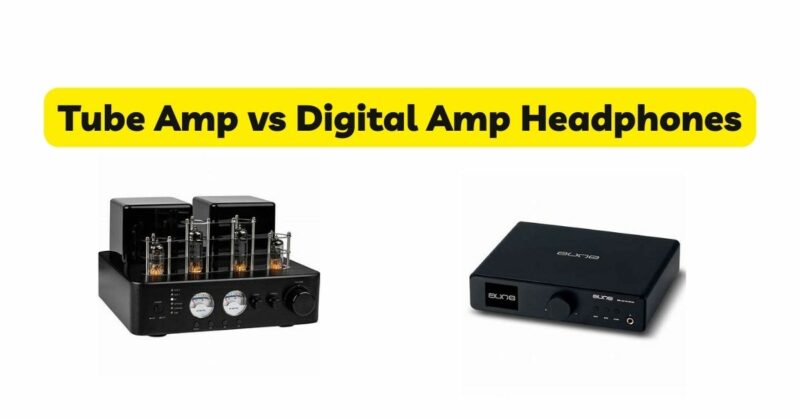The world of audio enthusiasts is filled with debates, and one that often surfaces is the comparison between tube amp and digital amp headphones. Both technologies have their ardent followers who swear by their preferred option. In this article, we will delve into the tube amp vs. digital amp headphone dilemma, examining their sonic characteristics, advantages, and drawbacks. By doing so, we aim to provide a comprehensive understanding of the two technologies and assist headphone enthusiasts in making an informed decision based on their preferences and requirements.
Part 1: Sonic Characteristics
Tube Amp Headphones: Tube amp headphones are renowned for their warm, smooth, and rich sound signature. The tube amplification introduces harmonic distortion and imparts a certain musicality and euphonic quality to the sound. The midrange tends to be lush and full, while the highs possess a pleasing sparkle without being harsh or fatiguing. Tube amp headphones are often associated with a wide soundstage, natural instrument separation, and a three-dimensional presentation that adds depth and realism to the listening experience. They excel in reproducing vocals, acoustic instruments, and genres that benefit from a warmer and more organic sound reproduction.
Digital Amp Headphones: Digital amp headphones utilize advanced digital signal processing (DSP) to drive the headphones. They aim to provide accurate and precise sound reproduction, often striving for a neutral or transparent sound signature. Digital amp headphones offer excellent detail retrieval, clarity, and instrument separation. They typically have a flatter frequency response, delivering a more faithful representation of the source material. Digital amp headphones are favored by listeners who prioritize accuracy and analytical listening, making them suitable for genres such as classical, jazz, and any music that demands a more precise and detailed sound reproduction.
Part 2: Advantages and Drawbacks
Tube Amp Headphones: Tube amp headphones come with several advantages that attract enthusiasts seeking a specific sonic experience. Their harmonic distortion adds a pleasing warmth and musicality to the sound, enhancing the emotional engagement of the music. Tube amp headphones often provide a smooth and forgiving listening experience, mitigating the harshness of poorly recorded tracks. They excel at reproducing vocals and acoustic instruments, infusing them with a natural and organic character. Tube amp headphones are also appreciated for their ability to recreate a spacious soundstage, immersing the listener in a more expansive and immersive musical environment.
However, tube amp headphones also have some drawbacks to consider. They tend to be more expensive than their digital counterparts due to the cost of tube components and the associated manufacturing processes. Tube amp headphones require periodic tube replacements as tubes degrade over time, adding to the cost of ownership. Additionally, tube amps can be bulkier, less portable, and require a power source to operate, limiting their usability in certain situations. Furthermore, tube amps may not pair well with all headphone models, as different headphones have varying impedance and sensitivity requirements.
Digital Amp Headphones: Digital amp headphones offer several advantages that have contributed to their rise in popularity. They often come in compact and portable designs, making them suitable for on-the-go listening. Digital amp headphones can be powered by battery, USB, or other portable devices, ensuring convenience and versatility. They typically have a lower cost of ownership, as they do not require tube replacements or maintenance. Digital amp headphones are known for their accuracy and precision in sound reproduction, providing a transparent and faithful representation of the source material. They are versatile and can easily adapt to different musical genres and recording qualities.
However, digital amp headphones are not without their drawbacks. Some enthusiasts argue that they lack the characteristic warmth, harmonic complexity, and the “tube magic” associated with tube amp headphones. The pursuit of extreme accuracy may lead to a sound that is perceived as clinical or analytical, which may not be preferred by listeners seeking a more euphonic or emotionally engaging sound experience. Additionally, the digital signal processing involved in digital amp headphones can introduce artifacts or unwanted digital noise if not implemented properly.
Part 3: Personal Preference and Usage Scenario
When choosing between tube amp headphones and digital amp headphones, personal preference and the intended usage scenario play significant roles. The decision depends on factors such as musical taste, desired sound characteristics, budget, portability requirements, and the listening environment.
If a listener prefers a warmer, more organic sound with a touch of euphony, and values the sonic qualities associated with tube amplification, then tube amp headphones may be the preferred choice. They are well-suited for genres that benefit from a warmer sound reproduction, such as jazz, blues, and vocal-centric music. However, it is important to consider the cost of ownership, the need for periodic tube replacements, and the portability limitations of tube amp headphones.
On the other hand, if accuracy, transparency, and versatility are paramount, digital amp headphones may be the better option. They provide a more neutral and faithful sound reproduction, making them suitable for genres that demand precision and detail, such as classical music or studio monitoring. Digital amp headphones often offer portability, convenience, and a lower cost of ownership.
Conclusion : The tube amp vs. digital amp headphone debate showcases the variety and personalization available in the audio world. Both technologies offer unique advantages and drawbacks, catering to different preferences and usage scenarios. Tube amp headphones provide a warm, rich, and euphonic sound signature, while digital amp headphones aim for accuracy, transparency, and versatility. Audiophiles and headphone enthusiasts should carefully consider their listening preferences, musical genres, budget constraints, and portability requirements before making a decision. Ultimately, the choice between tube amp headphones and digital amp headphones should be guided by personal preference and the desired listening experience.


